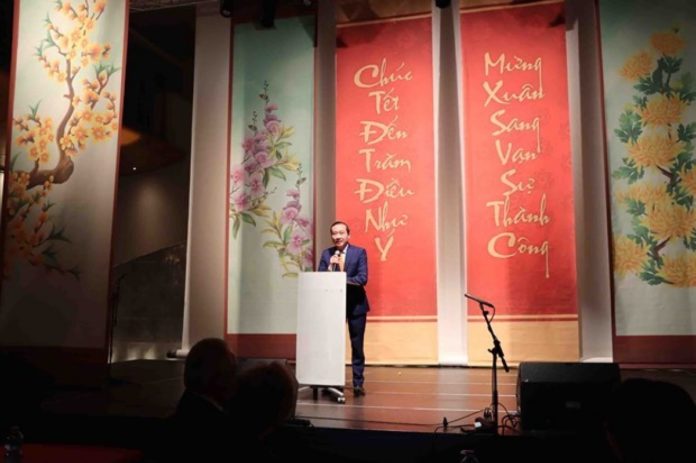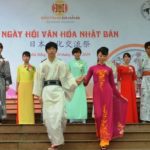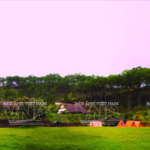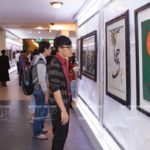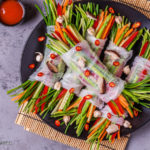The reportage said that about 400 Vietnamese people attended the traditional Tet festival in Woluwe Saint-Pierre district where not only Vietnamese people but also Belgians said to each other “Chuc mung Nam moi” (Happy New Year).
Visitors to the festival had a chance to enjoy Vietnamese traditional foods and fruits, particularly grapefruit – an indispensable fruit during Tet celebrations.
The channel’s reporter introduced “banh mi” (Vietnamese bread) – a specialty whose name is included in the Oxford Dictionary.
The festival was decorated with parallel sentences or calligraphy brought from Vietnam.
According to the reportage, hanging calligraphy is an indispensable decoration in the houses of Vietnamese people during Tet. To write calligraphy, one must learn for many years, and calligraphers look like performing martial arts when writing.
Besides, the Tet festival included a peformance by an art troupe from Ho Chi Minh City. The reportage emphasised that about 5,000 Vietnamese people are living in Brussels and that the Tet festival will take place for 15 days starting on January 22 which marks the first day of the Lunar Year of the Cat.
“Japanese Culture Festival” opens in Da Nang city
NDO/VNA – The Da Nang Museum held the “Japanese Culture Festival” 2019 in the central city of Da Nang on March 10 to introduce the beauty of the culture, land and people of Japan to locals and visitors, thus contributing to the strengthening of cultural exchange between the two countries and bilateral friendship.
Youth long to promote nation’s history
NDO—After three years, 10,000 copies of Ngan nam ao mu (A Thousand Years of Caps and Robes) by Tran Quang Duc have been sold—an impressive number for a history book. His friend, Nguyen Huu Su, is preparing to publish his book Lich su thu phap (History of Calligraphy). They are working on things they believe in.
Young Calligraphers Bring Their Work to the Streets
With their passion for calligraphy, young calligraphers in Ao dai and head dresses like their predecessors bring their work to the streets of Ho Chi Minh City in an activity that contributes to the preservation of calligraphy giving, a traditional Vietnamese custom to welcome Tet (the lunar New Year).
10 Best Vietnamese Food
Vietnamese food is known to be both healthy and robust in flavour, thanks its generous combination of fresh herbs and greens, paired with rice, noodles, seafood, pork and beef. While many cities such as Hanoi and Ho Chi Minh City offer plenty of fine-dining venues and five-star hotel restaurants decked out in extravagant settings, some of the best (and most authentic) Vietnamese delicacies are actually found at roadside eateries, vibrant street markets, and humble-looking restaurants. A typical meal includes rice or noodles, a meat or seafood dish, a vegetable dish, soup and nuoc cham (fermented fish sauce) for dipping, each of which can easily customised according to your preference. Here’s a helpful guide on what to eat in Vietnam, most of which can be enjoyed just about any time of the day. While most are familiar with pho or spring rolls, there’s a wide range of Vietnamese dishes only available in certain regions so be sure to try them out during your visit.

